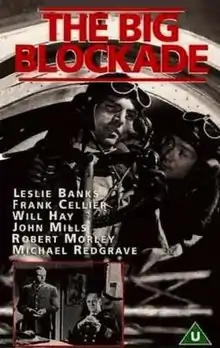| The Big Blockade | |
|---|---|
 British DVD cover | |
| Directed by | Charles Frend |
| Written by | Charles Frend Angus McPhail |
| Produced by | Michael Balcon |
| Starring | Leslie Banks Frank Cellier Will Hay John Mills Robert Morley Michael Redgrave |
| Cinematography | Wilkie Cooper Douglas Slocombe |
| Edited by | Compton Bennett Charles Crichton |
| Music by | Richard Addinsell orchestrated by Roy Douglas |
Production company | |
| Distributed by | United Artists Ltd (UK) |
Release date |
|
Running time | 73 minutes |
| Country | United Kingdom |
| Language | English |
The Big Blockade is a 1942 British black-and-white war propaganda film in the style of dramatised documentary. It is directed by Charles Frend and stars Will Hay, Leslie Banks, Michael Redgrave and John Mills. It was produced by Michael Balcon for Ealing Studios, in collaboration with the Ministry of Economic Warfare.[1][2][3]
At one stage, the film was known as Siege.[4]
Plot
This is a propaganda film in which the British strategy of the economic blockade of Nazi Germany is illustrated through a series of scenes and sketches, combined with documentary footage.
Although released in 1942 it was largely made in 1941 so part of the story is complaint of America's non-involvement.
Main cast
- Leslie Banks as Taylor, Civil Service
- Michael Redgrave as a Russian on the train
- Will Hay as Skipper, Merchant Navy
- Bernard Miles as Mate, Royal Navy
- Michael Rennie as George, Royal Air Force
- John Mills as Tom, Royal Air Force
- Frank Cellier as Schneider
- Robert Morley as the senior Nazi Official, von Geiselbrecht
- Alfred Drayton as Direktor
- Marius Goring as German propaganda officer
- Austin Trevor as U-boat Captain
- Morland Graham as Civil Servant
- Albert Lieven as Gunter
- John Stuart as Naval officer
- Joss Ambler as Stoltenhoff
- Michael Wilding as Captain
- George Woodbridge as Quisling
- Quentin Reynolds as American journalist
- Elliott Mason as German stationmistress
- Peter De Greef as RAF airman
The film's commentary is made by the journalist and former Liberal MP Frank Owen.
Release
The film premiered at the London Pavilion on 19 January 1942, and the premiere was attended by a group of members of Parliament interested in economic warfare.[5] The film was not well received by The Times, whose critic in 1942 found that "this particular hotch-potch is, as propaganda, woefully unconvincing. It is splendid to give audiences a glimpse of the devoted work done by the Services […] but actors got up as comic Nazi business men distort the lessons the more serious parts of the film are trying to drive home",[6] and modern film reviewers are not very much kinder to it.[7]
References
- ↑ "News From The Talkie Studios". The Chronicle. Vol. LXXXIV, no. 4, 804. South Australia. 15 January 1942. p. 33. Retrieved 18 August 2018 – via National Library of Australia.
- ↑ "Britain's New War Film". The Daily Telegraph. Vol. II, no. 42. New South Wales, Australia. 31 August 1941. p. 10. Retrieved 18 August 2018 – via National Library of Australia.
- ↑ "San Demetrio LONDON". The World's News. No. 2214. New South Wales, Australia. 13 May 1944. p. 9. Retrieved 18 August 2018 – via National Library of Australia. It intersperses actual film footage with sections of acting.
- ↑ "HIGHLIGHTS OF LONDON". Townsville Daily Bulletin. Vol. LXIII, no. 253. Queensland, Australia. 21 October 1941. p. 6. Retrieved 18 August 2018 – via National Library of Australia.
- ↑ The Times, 20 January 1942, page 2: News in Brief - found in The Times Digital Archive on 26 February 2014
- ↑ The Times, 14 January 1942, page 6: "The Big Blockade" - Fact and Fiction - found in The Times Digital Archive on 26 February 2014
- ↑ Dr Keith M. Johnston: The Great Ealing Film Challenge 65: The Big Blockade (1942). Retrieved 27 February 2014